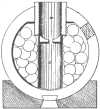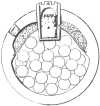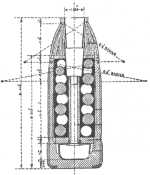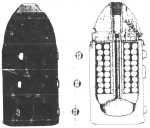|
| |
ShrapnelWL Ruffell | |
|
Shrapnel, the best mankiller the Artillery possessed for over a century, was invented by Lieutenant Henry Shrapnel, Royal Artillery. Before its introduction in 1803 the Artillery defeated attacks by Infantry or Cavalry with 'canister' or 'case', a tin container filled with iron balls or bullets varying in weight from 57 to 142 grams each, according to the nature of the gun. When the gun fired the container burst open at the muzzle, releasing the balls which spread out with a shotgun effect. Up to 300 metres it was guaranteed to cause heavy casualties. At longer ranges common shell, ie hollow cast iron spheres filled with gunpowder, were in use, but fragmentation was poor. They made a lot of noise but did no great damage. What Field Artillery needed was a long-range case shot. Lieutenant Shrapnel reasoned that if a shell filled with musket balls could be made to release them above the enemy's troops, they would carry on with the 'remaining velocity' of the shell, spread out and hit anyone who happened to be in the way. If the point on the trajectory at which the shell burst was well chosen the balls would reach the target with lethal velocity. Recognition and utilisation of this principle has perpetuated his name among Gunners.
| |
|
He first proposed 'spherical case' as he then called it in 1784, but the authorities took little notice. After all, he was only a Lieutenant. In December 1787 Shrapnel was able to demonstrate his principle before General O'Hara, Commander at Gibralter, using 8-in mortar shells filled with 200 musket balls mixed with a small charge of powder. Even this improvised effort was enough to impress those present, but no action was taken. In 1792 he made a formal approach to the Master General of the Ordnance who convened a committee to examine his proposal. After nine years the members reported that '... the effect appears to be very considerable ...' but '... do not take upon themselves to decide upon the policy of introducing it.' Innovation in those days usually suffered such treatment - especially if it was to cost money.
|

Figure 1. Original projectile. Click image to enlarge. |
At last on June 3 1803 Shrapnel was given the opportunity of demonstrating his shell before a Committee of Field Officers of Artillery, who approved it for service. Two months later he was ordered to the Carron Ironworks (near Falkirk, Scotland) to supervise its manufacture. Although officially termed 'spherical case' the original projectiles were called 'shrapnel' by the Gunners who fired them, and the name stuck. They were simply hollow cast iron spheres filled with a mixture of balls and powder, and fuzed with a crude time fuze, but they increased the effective range of case from 300 to about 1100 metres. Shrapnel was promoted Major on 1 November 1803 after eight years as a Captain. Records indicate the new weapon was first used at the Batavian settlement of Surinam on 30 April 1804 against the Dutch who surrendered after the opening rounds, so impressive was the effect. Shrapnel was promoted Lieutenant Colonel on 20 July the same year; people in high places were beginning to notice him. Although few, if any, historians mention the fact, a great deal of credit was due to Shrapnel's projectiles over the next decade for defeat of the French, who were never able to develop an answer to them. However, in recognition of his contribution to the 'state of the art' the British Government in 1814 awarded him £1200 a year for life. Although generally successful the early versions of shrapnel gave some trouble. Owing to friction between the balls and the powder of the filling, prematures sometimes occurred, so the first modification was to place the powder in a separate container (Fig. 2).
A further improvement was made in 1840 by inserting an iron diaphragm between powder and balls (Fig. 3). Both these improvements were due to Captain EM Boxer RA and were later incorporated into cylindrical shell for rifled ordnance (Fig. 4 and 5).
Shrapnel eventually rose to the rank of Lieutenant General on 10 Jan 1837 and died on 13 March 1842. He is a past Colonel-Commandant Royal Artillery, having been appointed to that office on 6 March 1827. In 1852, following a request from Shrapnel's family, the British Government ordered that spherical case henceforth be known officially as 'shrapnel' in honour of its inventor - and 'shrapnel' it has remained ever since. Although true shrapnel projectiles have been obsolete since 1935, the term 'shrapnel' is still used in a sense not technically correct to describe what should properly be defined as 'splinters' or 'fragments'. Manufacture of Armstrong's RBL guns ceased in 1864 (but those already made stayed in use for 20 years) and in what is now regarded as a retrograde step both Army and Navy reverted to rifled muzzle-loading (RML) ordnance until 1880 when they again adopted breech-loaders. From Figure 5 it can be seen that construction of RML shrapnel shells was almost identical to that of Armstrong, and they functioned in the same way.
| |
Shrapnel for early breech-loading guns made between 1880 and 1904 (the year the 18-pr was introduced) differed little from that of earlier types, except that the shells were fitted with driving bands instead of studs or lead sheathing. The shell illustrated in Fig. 6 represents the ultimate in shrapnel design. It functioned in the same manner as earlier types, and construction differed only in detail. Improvements in design enabled the wooden spacers to be dispensed with, and therefore more balls to be carried. Numbering about 300 in the 18-pr they were of lead approximately 13mm in diameter. To prevent movement which would have made the ball ballisatically unstable they were set in rosin. The balls had to reach the target with a velocity not less than 450fs (137m/s) to kill or inflict serious wounds. Thus the shell had to burst at just the right point on the trajectory; too far back, and they lost velocity and became ineffective, too far forward and the beaten zone on the ground was reduced in area. Amounting to only 1¾oz (50g) the powder charge in the tin box was sufficient only to eject the balls etc from the body of the shell which dropped to the ground intact. The balls carried on at the velocity of the shell at the point of burst, ie scattering its 'remaining velocity'.
| 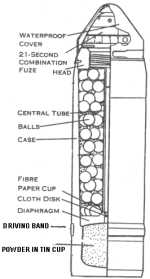
Figure 6. Shrapnel shell for QF 18-pr field gun introduced in 1904, declared obsolete in 1935. Click image to enlarge. |
|
WL Ruffell, 2001 Return to top | Wally Ruffell | The Armstrong Gun (Rifled breech-loaders) | History index | Home | |
